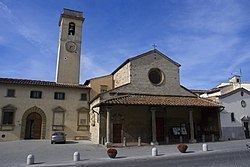Time zone CET (UTC+1) Postal code 50019 Local time Thursday 12:41 PM | Demonym(s) Sestesi Elevation 55 m Patron saint Martin of Tours | |
 | ||
Frazioni Cercina, Colonnata, Gualdo, La Zambra, Osmannoro, Padule, Querceto, Quinto Alto, Quinto Basso, Valiversi Weather 20°C, Wind W at 5 km/h, 47% Humidity | ||
Sesto Fiorentino, known locally as just Sesto, is a municipality (comune) in the province of Florence, Tuscany, central Italy.
Contents
- Map of 50019 Sesto Fiorentino Florence Italy
- History
- Main sights
- International relations
- In literature
- People
- References
Map of 50019 Sesto Fiorentino, Florence, Italy
History
The oldest known human settlement in the area dates from the Mesolithic (c. 9,000 years ago). The Etruscan presence is known from the 7th century BC, but the town proper was created by the Romans as Sextus ab urbe lapis ("Sixth mile from the Town Milestone"). The first churches were built in the early Middle Ages, among which the most important became the Pieve of San Martino. Sesto Fiorentino was subject to the Archbishop of Florence. Later it was under the Florentine Republic, which dried the plain and boosted the area's economy starting from the Renaissance age.
In 1735, Marquis Carlo Ginori founded one of the first porcelain plants in Europe, the Manifattura di Doccia. Now under the name Richard-Ginori, the company is still located in Sesto, and is the largest porcelain manufacturer in Italy. Toward the end of the 19th century, craftsmen who had been trained at Richard-Ginori began to start their own pottery studios, some of which also grew into factories. There are currently over one hundred producers of pottery in Sesto Fiorentino, and a state school for teaching pottery, now called L'Istituto Statale d'Arte.
Sesto Fiorentino was annexed by plebiscite to the newly unified Kingdom of Italy in 1860. The town was a protagonist in the late 19th century workers struggle, and in 1897 it elected the second socialist member ever of the Italian Parliament, Giuseppe Pescetti. In 1899 it was the first town in Tuscany to have a socialist mayor.
Main sights
International relations
Sesto Fiorentino is twinned with:
In literature
The book The Adventures of Pinocchio was set in Sesto Fiorentino.
Sherlock Holmes scholars determined that the unnamed Italian town in "The Adventure of the Empty House" was Sesto, and a bust of Holmes stands in the town.
People
Poet Alberta Bigagli was born in Sesto Firorentino in 1928.
